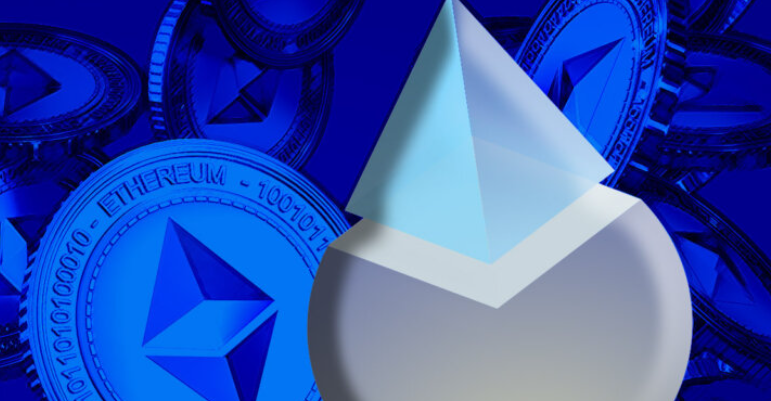Liquid staking refers to the process whereby decentralized network protocols create on-chain versions of staked assets. By tokenizing staked assets, these protocols enable staked assets to be used as collateral in various decentralized apps (dApps) in the decentralized finance (DeFi) market.
Derivative staked tokens represent an illiquid staking position and are exposed to the limitations of the underlying protocol. However, these tokens can be utilized in various financial products, providing stakers with additional yields and more options to manage their risk, such as reducing the risk of slashing associated with validators. Today we are going to examine the potential benefits and risks of tokenized staking positions in DeFi and analyse existing liquid staking protocols available in the market.
Introduction
The Merge, which was completed back in September 2022, had a tremendous impact on the Ethereum network. Its energy-intensive proof-of-work algorithm was replaced with the more energy-efficient proof-of-stake, which allowed validators to stake their Ether to maintain the security of the network in exchange for block rewards.
While the upgrade had mostly positive effects, there was a noticeable gap in one area — the amount of staked Ether within the network. To date, 16 million ETH has been deposited within the Ethereum Beacon Chain, amounting to a staggering $25.6 billion. However, that only represents 13.91% of the total Ether supply. In contrast, 387.9 million $SOL have been staked on the Solana network, representing 71.6% of the total $SOL supply. According to JP Morgan, the average for other proof-of-stake networks is about four times as high compared to Ethereum.
This difference can largely be attributed to the inability to withdraw staked Ether, an issue that should be remediated shortly with Ethereum’s Shanghai upgrade. Investors were reluctant to deposit their funds into Ethereum’s Beacon Chain if they did not have the option of withdrawal, perhaps fearing liquidity issues or are hesitant to incur significant opportunity costs.
Liquid staking protocols took advantage of the gap in the market and came up with a solution. These protocols would collect Ether from users for staking, and in return, issue Liquid Stake Derivatives (LSD) that would represent their users’ stake. In essence, the staked Ether became tokenized in the form of LSD tokens, which users can use in supported protocols to generate yield opportunities or engage in DeFi activities.
Advantages of Liquid Staking
As a validator on the Ethereum network, a user would have to first deposit 32 ETH to activate the validator software. They will then be responsible for storing data, processing transactions, and adding new blocks to the blockchain. This would require them to run an Ethereum node by constantly maintaining an online presence.
In addition, the user is expected to have a certain level of proficiency with the staking process, and would need to keep up to date with the network’s upgrades by reading up on relevant documentation and keeping track of communication channels with the developers.
Penalties would also be levied on a validator if he is derelict in his duties. Failure to maintain reliable uptime would incur penalties, with more severe offenses punishable by slashing — destroying a portion of an active validator’s stake. This is akin to a landlord confiscating a tenant’s security deposit for poor behavior.
Compared to that, a user on a liquid staking platform would have a much easier time staking his Ether.
- Low Barriers to Entry
There is no minimum threshold for participation, so users can start participating without the high upfront cost of 32 ETH, equivalent to $52,800 at the time of writing. This also serves as a great launchpad for new crypto investors who may be daunted by the high initial costs, and incentivise more people to join the crypto market.
At the same time, the user does not need to understand protocol details, such as the software or code required for maintaining a node, or even restrictions like unbonding periods and withdrawals. Since the user will only need to track his Ether holding and its prices, the entire process would be much easier and less stressful for the average investor.
- Participate in DeFi Activities
LSD tokens may be used in a variety of DeFi activities, such as staking, swaps, used as collateral, and more. This gives token holders a higher degree of freedom and a chance to further optimize their yield.
For example, instead of choosing to either stake Ether on the network or lend it on a DeFi lending platform, a user can stake his Ether on Lido for stETH, swap stETH for Ether on Compound, then lend it on a DeFi lending platform to get the best of both worlds.
- Improving Price Discovery
An important determinant in considering the fair value of a crypto asset is to ascertain the existence of an active market for it. This involves an evaluation of its trading volume and level of activity for the asset in question.
Proof-of-Stake protocols usually incentivize staking by using a large proportion of tokens to ensure the network’s security. This results in a situation where only a small percentage of unstaked tokens can participate in price discovery, which may hinder the asset’s growth in the long term. LSD tokens can be used in lieu of the staked tokens to improve the overall liquidity of the market, and allow it to realize its price potential in a more efficient manner.
Disadvantages of Liquid Staking
While there are disadvantages associated with liquid staking, we contend that these factors can be mitigated, and should not deter the growth of the sector as a whole.
- Systemic Risk
Liquid staking has implemented an additional point of failure for the crypto market, increasing the system risk for the DeFi ecosystem by adding another layer of complexity. The interactions between LSD tokens and the many different protocols may make the entire ecosystem more interwoven. Similar parallels can be drawn from the Great Financial Crisis of 2008, where a failure in one particular part of the ecosystem can lead to a greater domino effect that can affect the entire market.
Perhaps one of the most prevalent examples would be back in May 2022, when the collapse of Terra sent shockwaves throughout the entire industry. As companies like Celsius and Three Arrows Capital struggled with liquidity issues, they were forced to sell stETH, an LSD token, to raise capital for margin requirements and maintain cash flow. As a result, almost $800m worth of liquidity combined was removed from the stETH/ETH pool of Curve Finance.
This caused a massive imbalance in the liquidity pool, resulting in Ether accounting for less than 20% of reserves in the pool. Investors were worried that they could not withdraw their staked Ether, and the price of Ethereum sunk below $1000 to reach a yearly low of $800. All of this served to compound the negative impact of Terra’s collapse, and much of the failure may be attributed to companies over-leveraging into stETH.
However, a series of failsafe implemented in DeFi protocols have helped to circumvent the worst-case scenario, and make a catastrophic collapse unlikely. Most financial contracts in DeFi protocols are heavily overcollateralized, which is a big factor in reducing systemic risk. There is also a high level of transparency in the crypto market, with most information readily accessible on the blockchain.
We believe that the lack of moral hazard in the crypto industry is important. The collapse of big market players like FTX show that there are rarely any bailouts for poor management, and the increased risk in the industry necessitates prudent risk management for long-term survival. All of these factors support the existence of liquid staking, and prove that it offers more benefits than potential drawbacks.
- Risk to Decentralization
Liquid staking could lead to increased network centralization, as retail investors pool their assets to stake in liquid staking platforms like Lido. This also poses a risk towards network security, since theoretically, an entity can control the network’s consensus process by holding more than 2/3 of the voting power, though this may seem extremely unlikely given the current scale of the Ethereum network. Another more likely issue may be an outage on liquid staking platforms affecting the uptime of the Ethereum network. However, one may also argue that these platforms have extra motivation to perform at an optimal level, given the fierce level of competition in the liquid staking market and the potential damage to their reputation in the event of any failings.
Top Liquid Staking Platforms in the Market
ETH Beacon Chain Depositor. Source: Dune Analytics
Lido currently has almost 5 million Ether (worth around $8.4b at the time of writing) staked on the network, representing a staggering 29.36% of the market share. This is largely due to its first-mover advantage, as it was launched almost 3 years ago in December 2020.
Lido utilizes non-custodial staking, which means that the protocol does not control the private keys of the assets used in the staking process. This is especially relevant in today’s regulatory climate, as the Securities and Exchange Commission (SEC) has been going after a large number of centralized crypto platforms for their staking-as-a-service (SaaS) offerings.
Earlier this month, the SEC accused Kraken of selling unregistered investment contracts, with the reasoning that the act of staking has regular returns and payouts. Kraken ended up settling the charges by agreeing to shut down its staking program in the U.S. and paying a $30 million fine.
It is unknown if the SEC would continue to target other companies. However, most investors appear unwilling to take the risk, and have decided to divert their funds to decentralized platforms like Lido instead. This is especially concerning for Coinbase, as it also has a liquid staking program that rewards users with its Coinbase Wrapped Staked ETH (cbETH).
Liquid Staking TVL Rankings. Source: DeFi Llama
As highlighted by analytics platform DeFi Llama, Coinbase ranks second in terms of total value locked (TVL) in liquid staking at $1.86b. This is particularly noteworthy given that Coinbase is among the first established corporations to enter the liquid staking market, which has traditionally been dominated by decentralized protocols. Users may place more trust in Coinbase compared to other liquid staking protocols due to its well-established reputation and exceptional customer support. Additionally, Coinbase users may opt for the platform’s liquid staking services for the sake of convenience, especially if they are already conducting most of their cryptocurrency activities on the platform. However, it remains to be seen how the recent actions taken by the SEC will impact liquid staking in centralized institutions, and it will be interesting to see if Coinbase’s liquid staking service may experience any adverse effects as a result.
In third place is Rocket Pool, a decentralized protocol with just over $1b in TVL. Rocket Pool seeks to differentiate itself from market leader Lido by introducing the ability for users to operate their own nodes.
Instead of the usual 32 Ether needed to run a node, users on Rocket Pool can do so with just 16 Ether. Users running a node will also not be charged any fees by the protocol, and can even earn additional rewards in the form of RPL tokens. Doing so can earn the user 7.24% APR with additional RPL in rewards. In contrast, Lido offers around a 5.2% APR at the time of writing. However, it is important to note that the advantage only goes to Rocket Pool should a user choose to run a node. Otherwise, the yield for staking on Rocket Pool stands at 4.7% APR at the time of writing. Nevertheless, Rocket Pool represents a viable alternative for tech-savvy users who wish to earn a higher yield, and are willing to run a node to do so.
The Impact of the Shanghai Upgrade
Ethereum developers have agreed upon 28th February 2023 as the target date to push through the Shanghai upgrade for the Sepolia testnet. Following that, the largest testnet Goerli will also receive the upgrade before Shanghai goes live on the mainnet.
The Shanghai upgrade for the Ethereum network is expected to be completed in March 2023, and it may have far-ranging implications for liquid staking as a whole. For one, stakers will finally be able to withdraw their Ether and claim their staking rewards. This would make direct staking a more attractive option as compared to liquid staking. In addition, many users who have built up rewards through liquid staking may also wish to withdraw their rewards. Both would result in a loss of liquidity from liquid staking protocols, and may even threaten their viability and survivability in the long term.
However, proponents of liquid staking have offered an alternate viewpoint — that the Shanghai upgrade would be a boon for the whole market. Since liquid staking platforms are primarily concerned with the staking rewards — they take a cut of the user’s staking reward as their primary source of revenue — their revenue should increase with the Shanghai upgrade. After all, an upgrade as hyped up as the Shanghai upgrade would grab the attention of investors worldwide, and the resulting increase in on-chain activities should also contribute to a potential rise in Ethereum’s price. Because of this, we may expect the revenue of liquid staking platforms to rise, or at the very least, stay at the current level.
Another way for liquid staking platforms to retain their competitive edge is to find ways to boost the utility and yield for their LSD tokens. A popular option to do so is through Aura, a decentralized social aggregation platform that uses Balancer to maximize yield for its users. Rocket Pool has partnered with Aura to see incredible growth, with its primary Rocket Pool ETH pool (rETH — ETH) seeing a growth of over 400% in liquidity within 4 months. Having a higher liquidity is essential to reduce price volatility for the LSD tokens, and the increased yield from leveraging on Aura is also a crucial competitive edge.
Aura’s Competitive Edge. Source: Twitter
Finally, liquid staking platforms will likely remain relevant after the Shanghai upgrade for one reason — liquidity. More specifically, we refer to the unbonding periods for staking.
Unbonding Period for Blockchain Networks. Source: Coinbase
Traders who are engaging in leverage trading or have collateral locked within DeFi protocols run the risk of liquidation if their position meets a margin call or becomes undercollateralized. When that happens, they may need capital urgently. The unbonding period for Ethereum remains unknown, though it may take a few days like the other layer 1 networks. Therefore, traders who wish to remain flexible in their trading strategies may choose to employ the services of liquid staking protocols instead.
Conclusion
In conclusion, liquid staking represents a new development in the DeFi market, providing stakers with an easier and more accessible way to participate in staking, and offering them additional yields and options to manage their risk. Liquid staking derivatives have many advantages, including low barriers to entry, the ability to participate in DeFi activities, and improving price discovery. However, there are also potential disadvantages, such as systemic risk and the risk to decentralization. Nevertheless, the recent Shanghai upgrade for the Ethereum network is expected to have a positive impact on the liquid staking market. As unbonding periods for staking remain unknown, traders who wish to remain flexible in their trading strategies may choose to employ the services of liquid staking protocols instead. Also, as the DeFi market continues to grow, it is likely that liquid staking will play a significant role in shaping the future of the crypto market.
 English
English
 Deutsch
Deutsch
 Español
Español
 Français
Français
 Português
Português
 日本
日本
 한국인
한국인
 Türkçe
Türkçe
 Русский
Русский
 Tiếng Việt
Tiếng Việt














